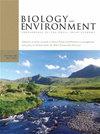针叶林对爱尔兰水源中褐鳟和大西洋鲑鱼的影响对比
IF 0.6
4区 环境科学与生态学
Q4 ENVIRONMENTAL SCIENCES
Biology and Environment-Proceedings of the Royal Irish Academy
Pub Date : 2022-01-01
DOI:10.3318/BIOE.2014.20
引用次数: 6
摘要
摘要:2008年对爱尔兰共和国境内64条一、二级水源进行了鲑鱼种群抽样调查。溪流是从邻近的小集水区中选择的,这些小集水区主要是沼地或针叶林,跨越两种土壤类型——泥炭土和矿物土。一年中,一系列化学变量被测量了三次。对每条河流中的褐鳟和大西洋鲑鱼种群的密度和生物量进行了一次量化。对数据进行了分析,以检验零假设,即土地利用和土壤类型对溪流中的鱼类或化学指标都没有显著影响。从绿化集水区流出的河流pH值显著降低,ΔpH显著降低,TDOC、总磷、总单体铝、氨和颜色显著升高。泥炭土子集水区的最小pH值和TON值显著降低,而悬浮物、TDOC、氨、铝和色度较高。褐鳟的密度和生物量在造林后的流域有所降低,但差异不显著。然而,大西洋鲑鱼幼鱼的密度和生物量在排水绿化集水区明显较低。大西洋鲑鱼对有害森林介导的水化学的耐受阈值也比鳟鱼低得多。尽管空气中的硫酸盐污染物有所减少,但森林介导的溪流酸化显然仍对大西洋鲑鱼种群构成严重威胁,给森林和渔业管理者带来了挑战。本文章由计算机程序翻译,如有差异,请以英文原文为准。
Contrasting impacts of conifer forests on brown trout and Atlantic salmon in headwater streams in Ireland
Abstract:ABSTRACTSalmonid populations were sampled in 64 first- and second-order headwater streams throughout the Republic of Ireland in 2008. Streams were selected from neighbouring sub-catchments dominated either by moorland or conifer plantations, across two soil types—peat soil and mineral soil. A range of chemical variables were measured on three occasions over the year. Brown trout and Atlantic salmon populations were quantified on a single occasion for density and biomass in each stream. Data were analysed to test the null hypothesis that neither land use nor soil type had a significant impact on fish or chemical metrics in the streams. Streams draining afforested catchments had a significantly lower pH, ΔpH and elevated TDOC, total phosphorus, total monomeric aluminium, ammonia and colour. Streams draining peat soil sub-catchments had significantly lower minimum pH and TON, and higher suspended solids, TDOC, ammonia, aluminium and colour. While density and biomass of brown trout were somewhat lower in afforested catchments, the difference was not significant. Densities and biomass of juvenile Atlantic salmon, however, were significantly lower in streams draining afforested catchments. Atlantic salmon also had a much lower threshold tolerance to deleterious forestry-mediated water chemistry than trout. Forestry-mediated acidification of streams apparently remains a severe threat to Atlantic salmon populations, despite the reduction of airborne sulphate pollutants, posing challenges to forest and fisheries managers.
求助全文
通过发布文献求助,成功后即可免费获取论文全文。
去求助
来源期刊
CiteScore
1.10
自引率
0.00%
发文量
6
审稿时长
>36 weeks
期刊介绍:
The journal aims to offer a broad coverage of the subject area, including the following:
- biology and ecology of the Irish flora and fauna
- microbial ecology
- animal, plant and environmental physiology
- global change
- palaeoecology and palaeoclimatology
- population biology; conservation of genetic resources
- pollution and environmental quality; ecotoxicology
- environmental management
- hydrology
- land use, agriculture, soils and environment.
Submissions on other relevant topics are also welcome, and papers of a cross-disciplinary nature are particularly encouraged.

 求助内容:
求助内容: 应助结果提醒方式:
应助结果提醒方式:


